A crusty, no-knead, sourdough bread with a delightfully soft texture and deliciously tangy flavor. The dough is mixed one day and baked the next, giving it an elevated taste and texture.
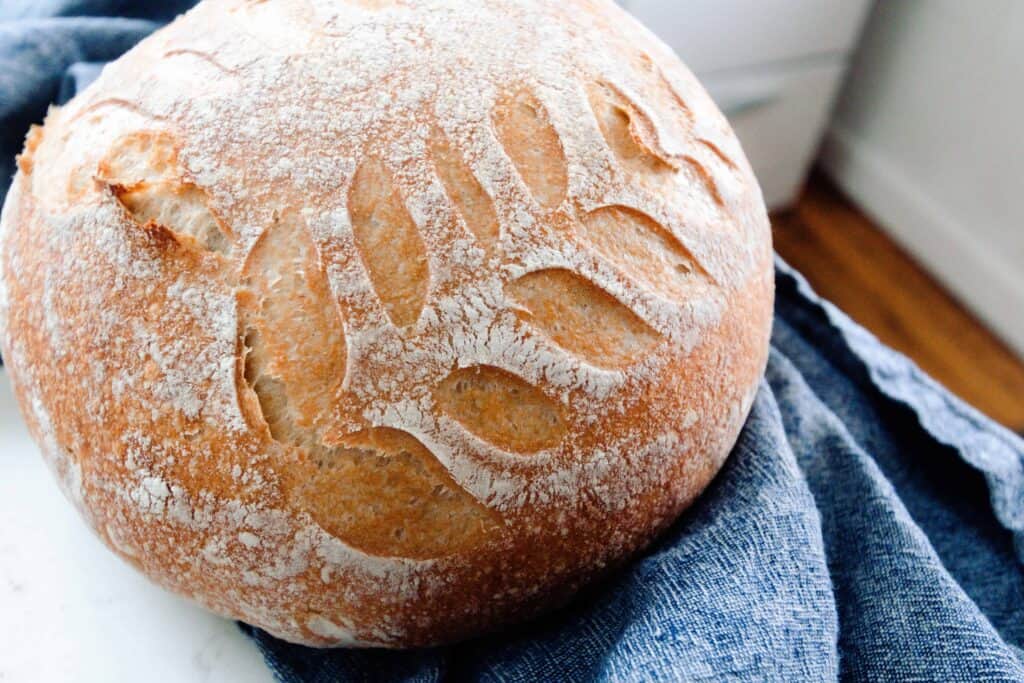
Crusty loaves of sourdough bread are an absolute staple in our house. This is an art I continue to work at mastering, but I also think of it as a hobby. I enjoy working on my sourdough recipes, fine tuning and perfecting them.
I’m hoping this will also become a passion for my children one day, as they reflect back on the memories of fresh bread and time spent in the kitchen. How fortunate to find a hobby kind of joy in a simple, everyday kind of task!
Learning makes me happy, and learning how to make the perfect loaf and mastering beautiful designs can be incredibly satisfying. I continue to find that the extra special attention to detail makes all the difference, especially with sourdough.
See, sourdough can be fickle. Sometimes a loaf doesn’t turn out just right. Don’t get me wrong, we still eat it.
We might turn it into a breakfast Strata, stuffing, or cut it in half and make pizza bread, but we still eat it.
After experimenting for weeks to create the perfect, artisan-style, no-knead bread, I finally feel like I nailed it.
This process and recipe has given me consistently good loaves, so that’s why I’m excited to share it!
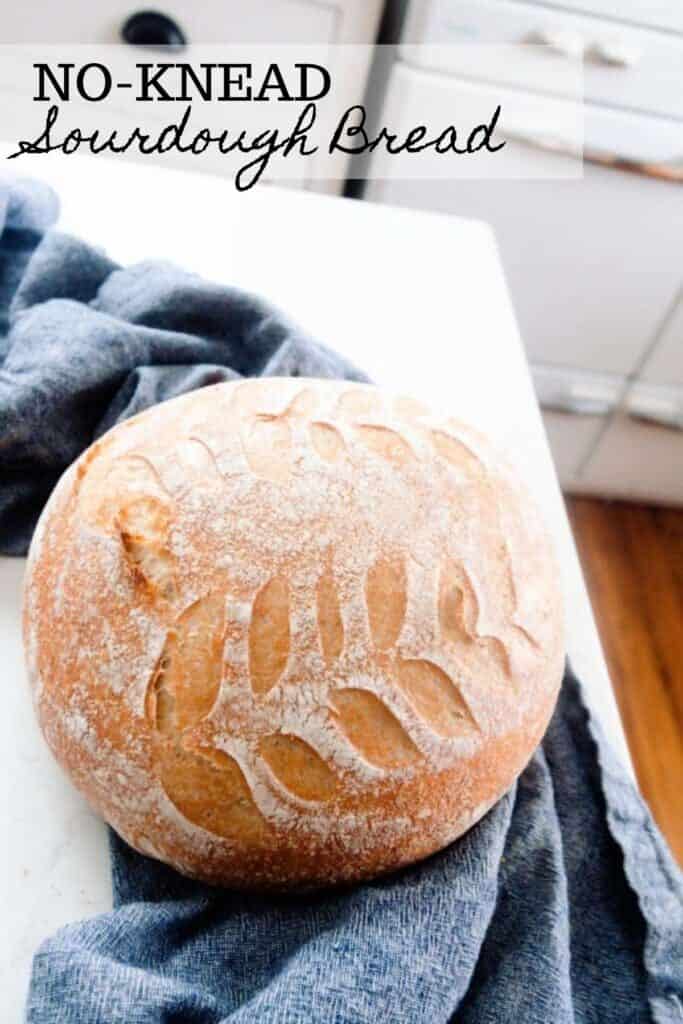
What is sourdough bread?
Sourdough bread is a fermented bread that uses natural wild yeast to rise, rather than relying on commercial yeast.
It is a healthier choice, plus many people who are sensitive to gluten (not celiac) can tolerate sourdough products, due to the fermentation of the grains.
Phytic acid (that is naturally present in wheat), which is an anti-nutrient that blocks absorption of the nutrients found in wheat, gets broken down during the fermentation process. This breakdown, in turn, makes the nutrients more available for your body to absorb.
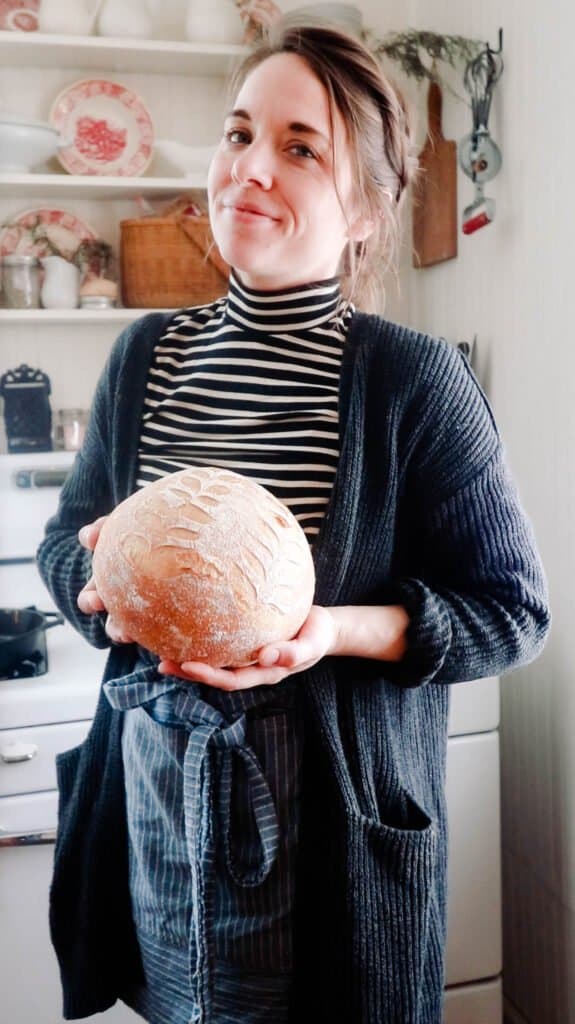
How do you make a sourdough starter?
Creating a sourdough starter is actually pretty simple. It is the process of mixing water and flour together for multiple days until yeasts are captured and the flour bubbles. You can find the tutorial on how to make a sourdough starter here.
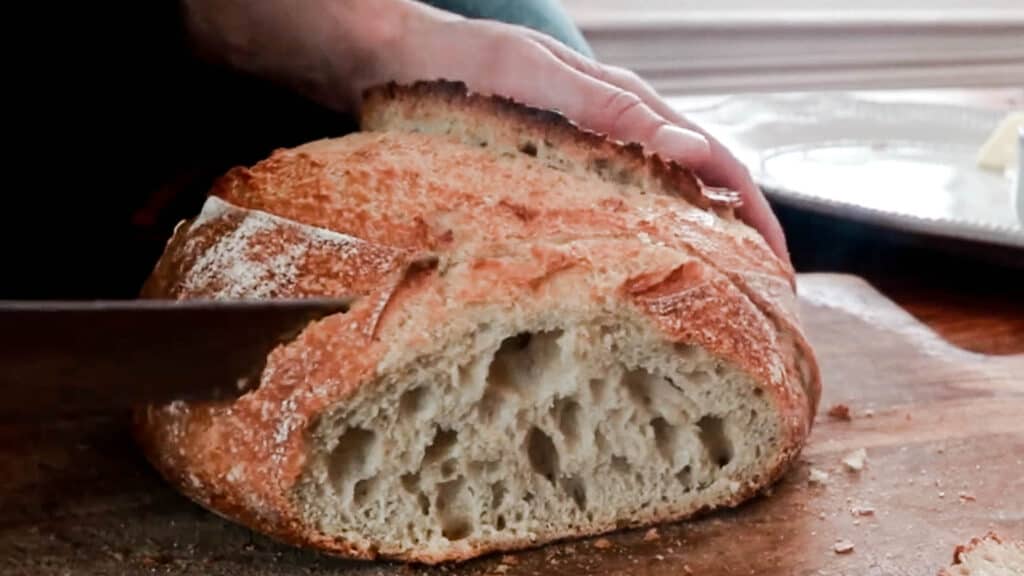
Is it necessary to knead sourdough?
Not necessarily. The act of kneading is supposed to help create gluten formation in the bread, which can then help create a good texture and air pockets in the bread. But no-knead sourdough bread uses other methods to develop the gluten.
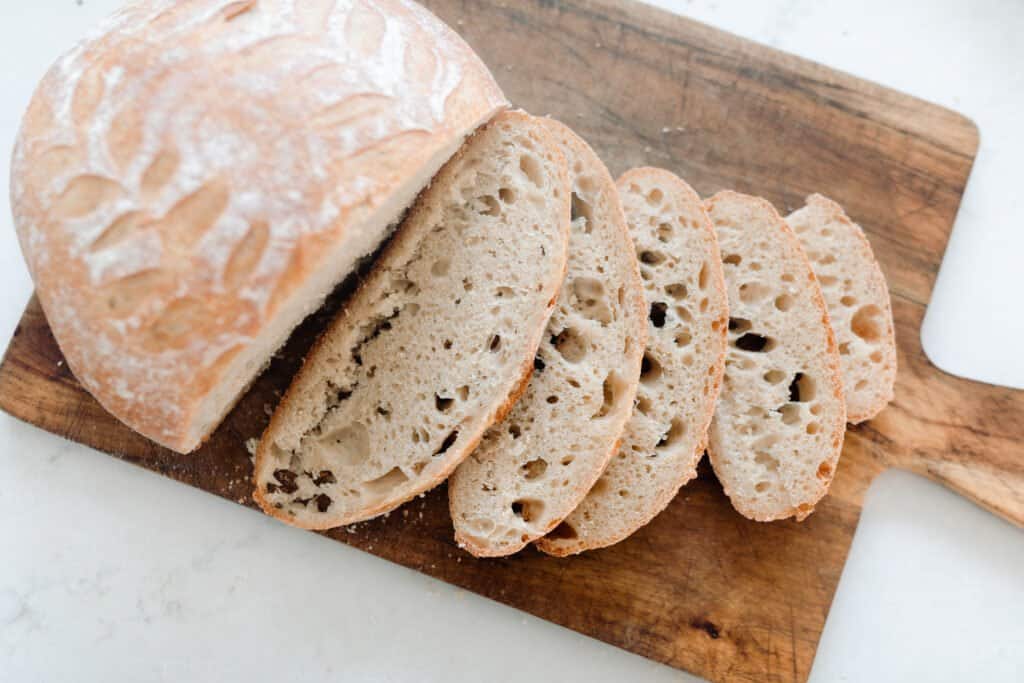
How does no-knead sourdough work?
In no-knead versions, the gluten develops during the stretching and folding process, as well as during the bulk fermentation process, which helps create those glorious air pockets.
This post contains affiliate links, which means I make a small commission at no extra cost to you. See my full disclosure here.
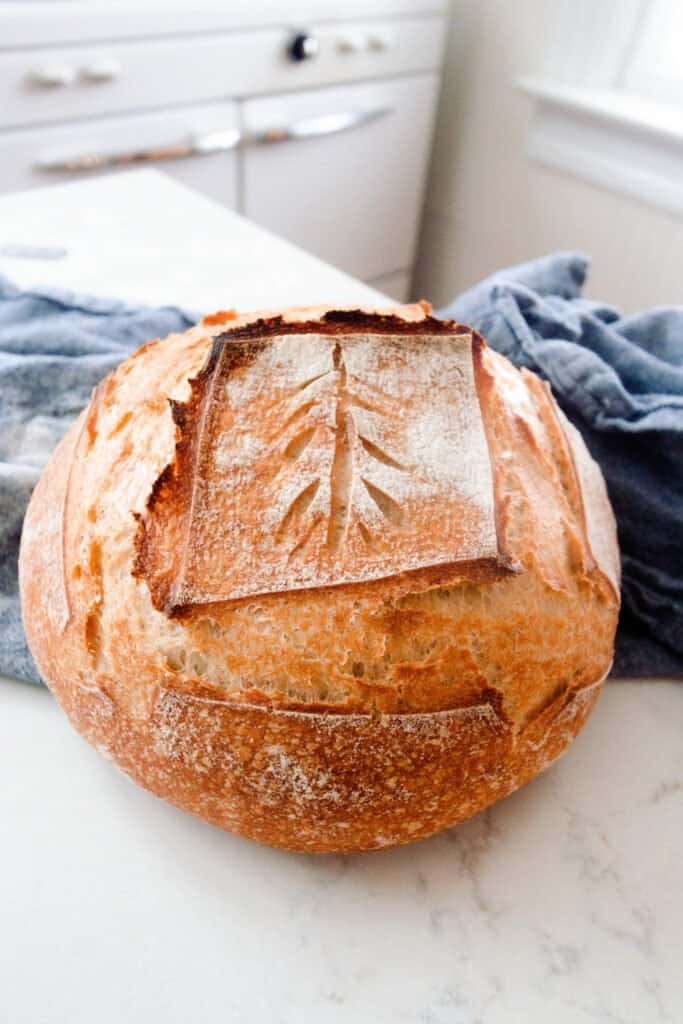
Tips For Success:
- You will need an active sourdough starter to create a well-risen bread. Check out how to make a sourdough starter and how to care for one.
- Cover the dough with a damp towel, beeswax wrap, or plastic wrap to ensure that an unpleasant crust doesn’t develop.
- The amount of time it takes for your dough to double can be determined by many environmental factors, such as the temperature in your home, the maturity of your starter, and the hydration status of the loaf.
- The most accurate way to get the best loaves of bread each time is to measure your ingredients with a kitchen scale.
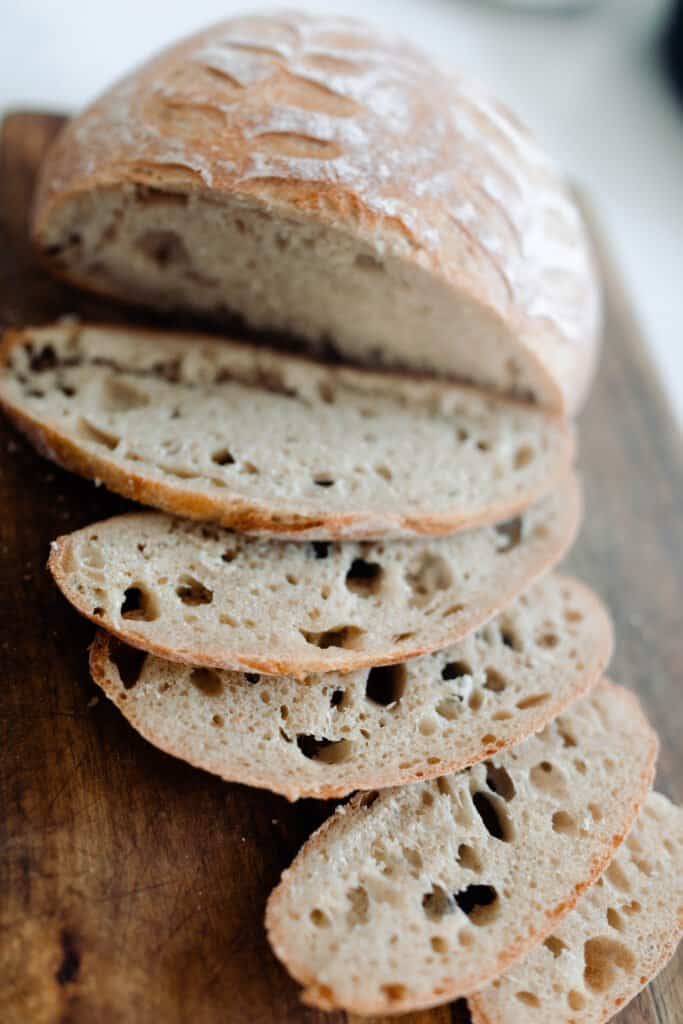
Tools you may need to make this recipe:
Large bowl
Kitchen scale
Banneton (optional)
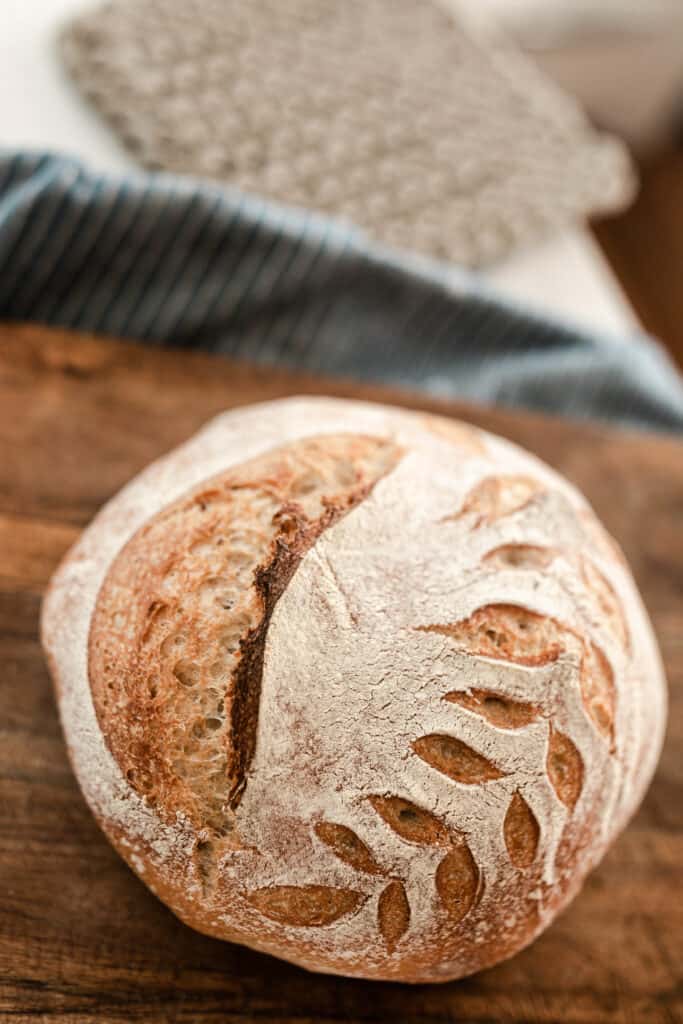
How To Make No-Knead Sourdough Bread
Feed a sourdough starter 4-12 hours before starting the bread, ensuring it is active and bubbly.
Combine warm water and flour. Allow to rest for 30 minutes for the water to hydrate the flour. This process is called autolyse.
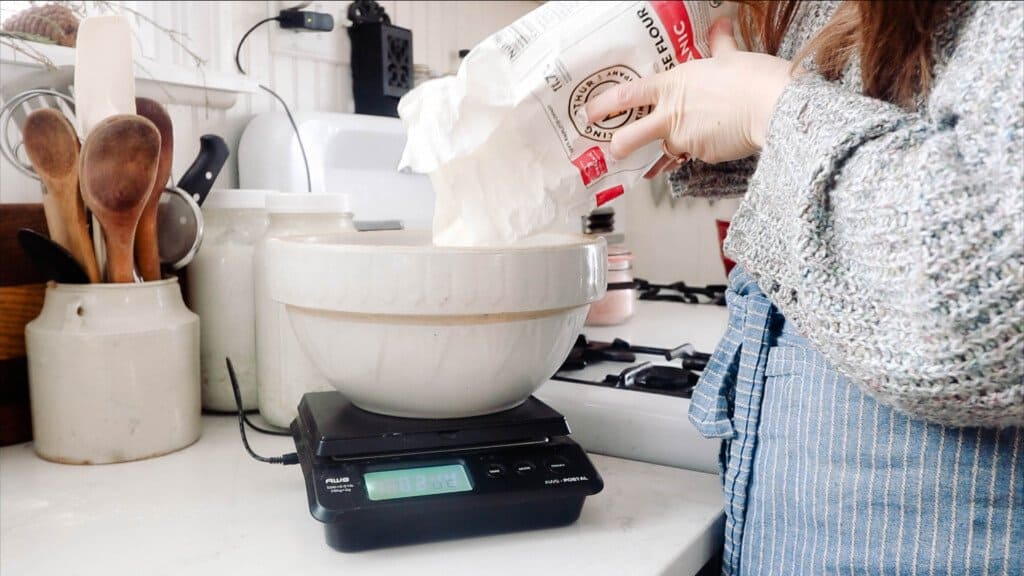
Add sourdough starter. Dimple in with wet hand.
Sprinkle salt on top.
Mix the dough with your hands for about 5 minutes to bring the dough together. Cover with damp towel or plastic wrap while resting.
Cover with plastic wrap or damp towel and let rest for 30 minutes.
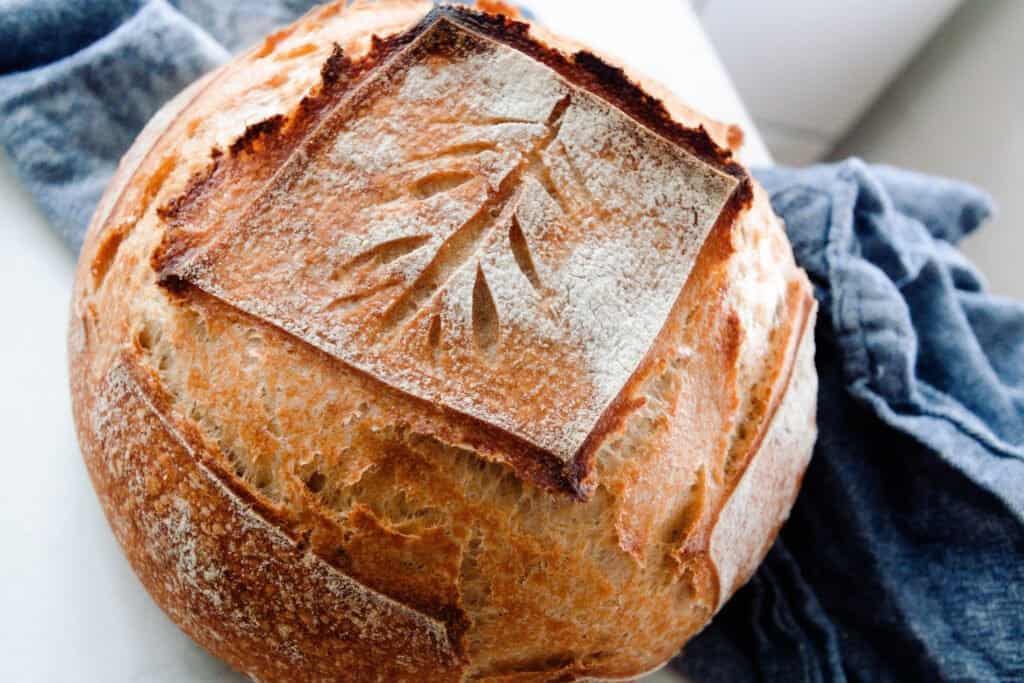
Stretch And Fold
To develop the gluten and obtain a nice rise, you will want to do 6 rounds of stretching and folding.
While the dough is in the bowl, grab the edge and the dough firmly and pull up, stretching it upwards. Then place the dough in your hands into the center. Turn the bowl about a quarter turn and do this stretch and fold again, and again one to two more times. This is considered one stretch and fold round. Repeat according to the directions below. Dip your hand in water if the dough is too sticky.
First 3 stretch and folds – every 15 minutes.
Last 3 stretch and folds – every 30 minutes.
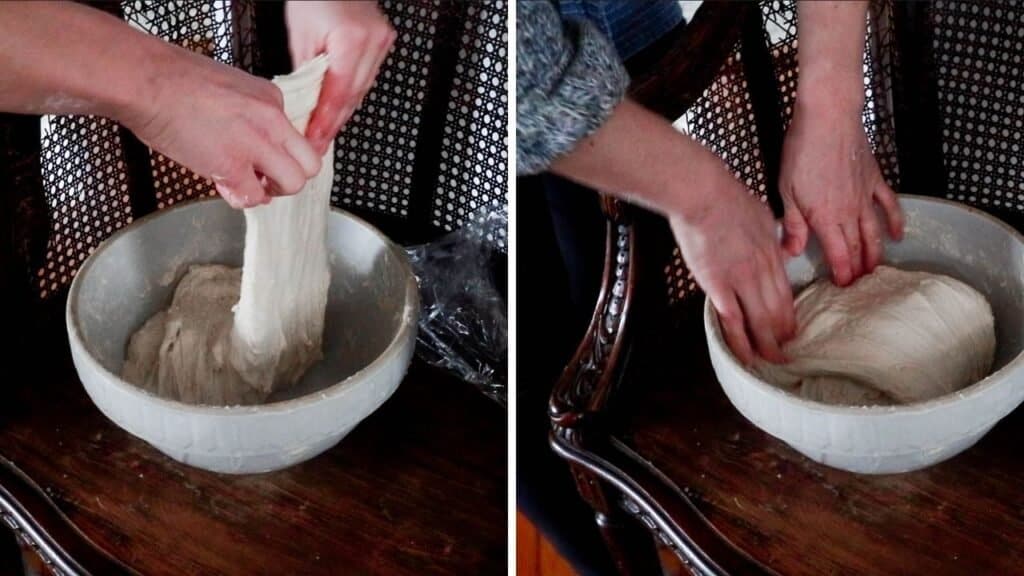
Cover with a wet towel or plastic wrap and allow the dough to bulk-ferment until doubled.
The timing for this will vary depending on temperature, hydration, and maturity of your starter. You could also let this step go longer for further health benefits. I do this in the morning and then let it go all day.
When it’s done, there will be bubbles all over the surface.
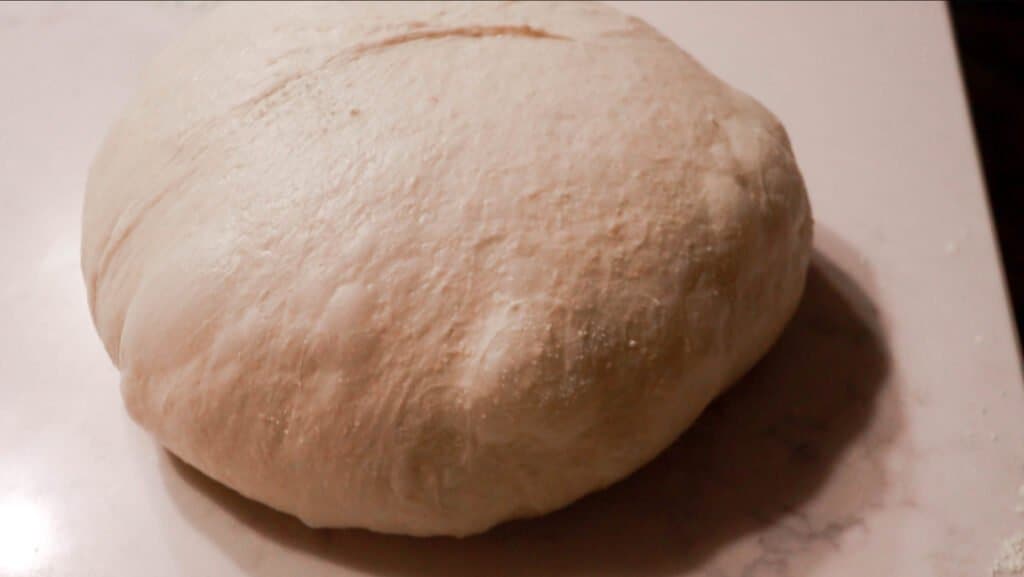
Split the dough in half down the middle with a dough scraper. Be really careful not to break any of those precious bubbles.
Shape into a ball by gently spinning it toward you.
Set out 15-20 minutes uncovered. This allows the surface to develop a skin, so that it doesn’t stick to the tea towel during the overnight rise.
Turn over and shape. I do this by folding the two sides over to meet in the middle, and then the other two sides.
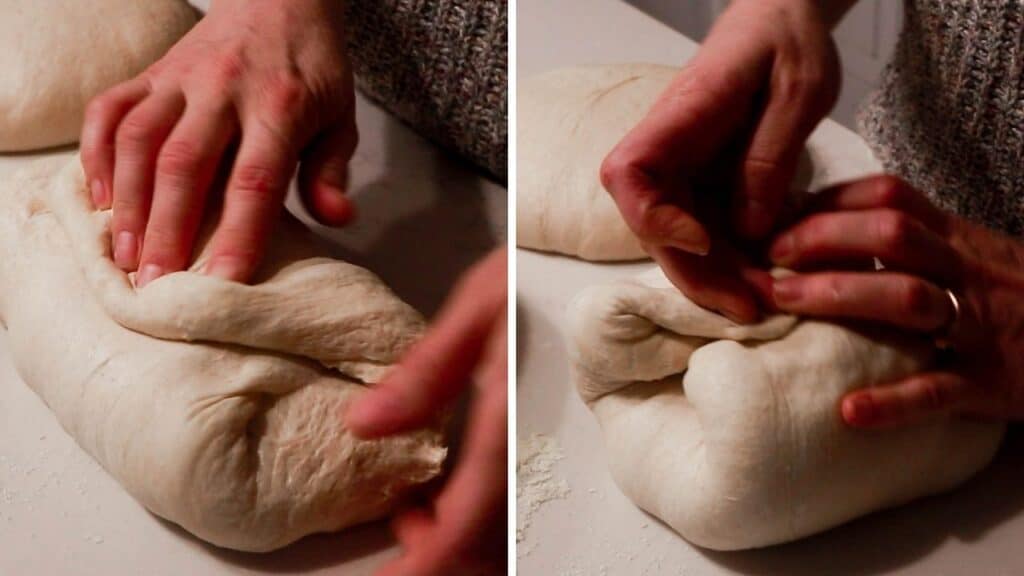
Repeat with the other half of the dough. This recipe yields two loaves.
Transfer to flour banneton or bowl with tea towel, seam side up. Cover with plastic and proof 12-15 hours in refrigerator.
Bake
Preheat dutch oven to 500 degrees for 1 hour.
Remove dough from the fridge immediately before scoring and baking.
Dust with flour on top to make the scoring pattern stand out more.
Score with a razor.
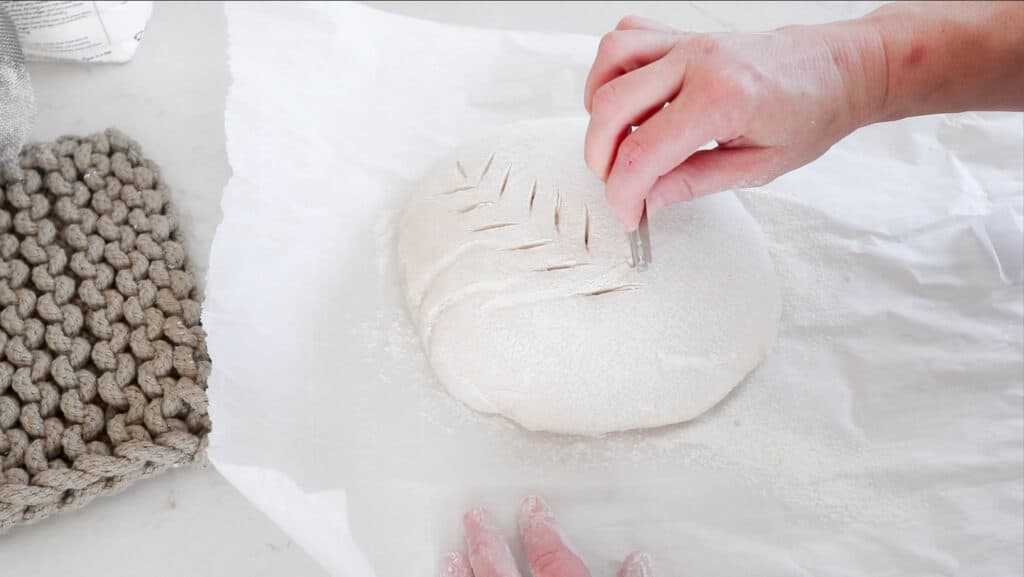
Add a little flour to the bottom of the dutch oven (or parchment paper) and transfer dough to it.
Bake for 20 minutes at 500 with lid on.
Take lid off, turn the oven temperature down to 475, and bake an additional 25 minutes or until browned.
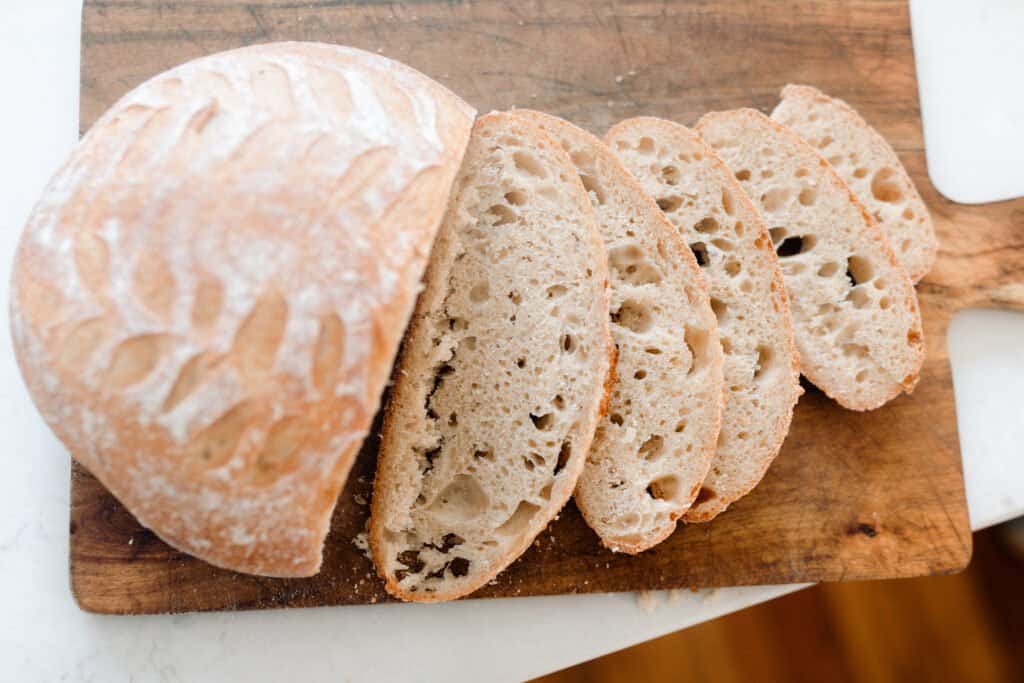
Tips for making your sourdough bread pretty
- Don’t skip the long rising time in the refrigerator. Bread dough takes forever to rise in the refrigerator, but this chilling process does make the final scoring pattern prettier. I’ve never had success with a beautiful scoring design when skipping this step.
- Dust a bit of flour over the surface before scoring. This will allow the design to stand out better.
- Use a razor. I know it’s tempting to just grab a sharp knife to score your bread, but proper bread scoring razors do yield a more beautiful result.
- Do an online image search for scoring patterns, and try your hand at a few tried and true designs before getting creative with your own.
- Practice, practice, practice. You will figure out just how deeply you need to cut, and how the design spreads during baking, by trying over and over again. The good news is you’re just going to eat it no matter what. We’ve eaten many an ugly loaf of bread, and they all tasted great.
Bakers Timeline For No-Knead Sourdough Bread
8 am: Feed sourdough starter with flour and water.
12 pm: If sourdough starter is mature, then proceed to creating the dough.
Combine the warm water and flour. Rest for 30 minutes.
12:30-ish pm: Add in sourdough starter and dimple in with wet hand.
Sprinkle salt on top.
Mix the dough with your hands for about 5 minutes. Cover with damp towel or plastic wrap. Rest for 30 minutes.
1:00ish pm: Stretch and fold.
First 3 stretch and folds – every 15 minutes
Last 3 stretch and folds – every 30 minutes
Cover with a wet towel or plastic wrap and allow the dough to bulk ferment until doubled.
8:00pm (may be much sooner): Split the dough in half down the middle with a dough scraper.
Shape dough.
Sit out 15-20 minutes, uncovered.
Turn over and shape.
8:30pm: Transfer to flour banneton or bowl with tea towel and cover with plastic. Place in the refrigerator for 12-15 hours.
The Next Day
9:00am: Preheat dutch oven on 500 for 1 hour.
Take dough out of fridge, dust with flour, and score.
10:00am: Bake the sourdough bread and allow to cool.
Find More Delicious Sourdough Recipes:
- Homemade Sourdough Bagels
- Sourdough Coffee Cake
- Sourdough Chocolate Chip Cookies
- Einkorn Sourdough Bread
- Sourdough Chocolate Cake
If you try this recipe and love it, I would love if you could come back and give it 5 stars! Tag me on Instagram @farmhouseonboone
No-Knead Sourdough Bread
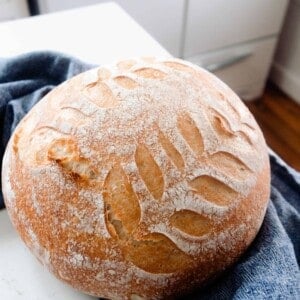
Ingredients
- 500 g unbleached all purpose
- 200 g freshly ground whole wheat
- 250 g bread flour, can omit and just add more to the unbleached all purpose
- 200 g mature starter, active and bubbly
- 650 g water
- 20 g salt
Instructions
- Feed a sourdough starter 4-12 hours before starting the bread, ensuring it is active and bubbly.
- Combine warm water and flour. Allow to rest for 30 minutes for the water to hydrate the flour.
- Add sourdough starter. Dimple in with wet hand.
- Sprinkle salt on top.
- Mix the dough with your hands for about 5 minutes to bring the dough together. Cover with damp towel or plastic wrap while resting.
- Cover with plastic wrap or damp towel and let rest for 30 minutes.
STRETCH AND FOLD
- First 3 stretch and folds – every 15 minutes.
- Last 3 stretch and folds – every 30 minutes.
- Cover with a wet towel or plastic wrap and allow the dough to bulk ferment until doubled.
- Split the dough in half down the middle with a dough scraper. Be really careful not to break any of those precious bubbles.
- Shape into a ball by gently spinning it toward you.
- Set out 15-20 minutes uncovered.
- Turn over and shape.
- Transfer to flour banneton or bowl with tea towel. Cover with plastic and proof 12-15 hours in refrigerator.
Bake
- Preheat dutch oven on 500 for 1 hour.
- Remove dough from the fridge immediately before scoring and baking.
- Dust with flour on top to make the scoring pattern stand out more.
- Score with a razor.
- Add a little flour to the bottom of the dutch oven (or parchment paper) and transfer dough to it.
- Bake for 20 minutes at 500 with lid on.
- Take lid off, turn the oven temperature down to 475 and bake an additional 25 minutes or until browned.
Notes
- Make sure your starter is very active and bubbly.
- Depending on temperature, hydration and maturity of starter will determine the amount of time it takes for it to double in size.
- To increase the health benefits you could allow the bread to ferment longer. I start the bread in the morning and then let it ferment all day.
Nutrition
Nutrition information is automatically calculated, so should only be used as an approximation.
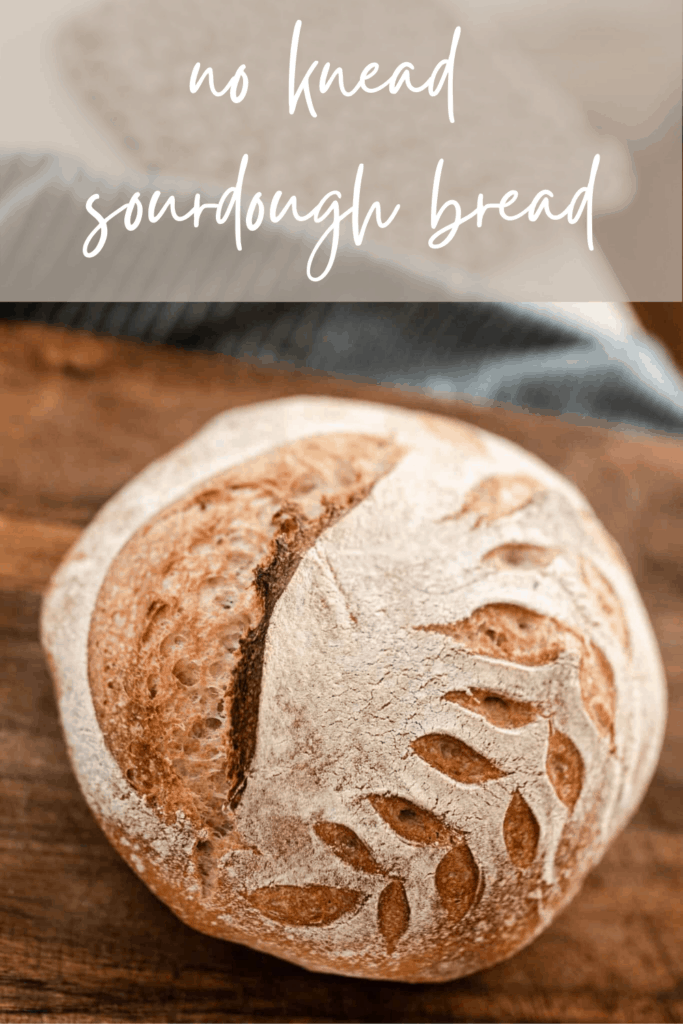
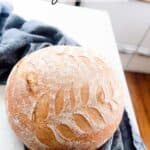
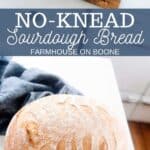
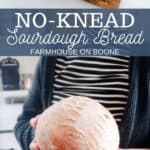
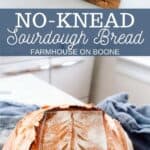
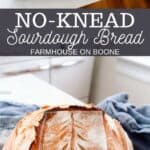
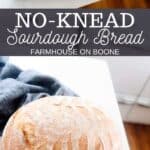
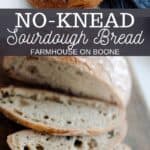
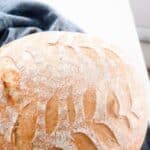
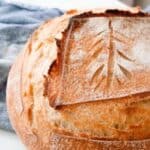
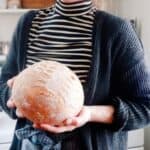
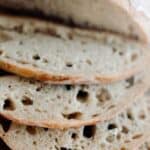










Made it today. What a treat!
That is so wonderful to hear.
My loaves keep turning out flat, but during the bulk ferment it does great any ideas?
Is it over fermenting? Does the dough shape up well right before baking? Could be a steam issue in your oven. Are you heating your dutch oven?
Hi all, I want to divide each loaf in half to make smaller loaves, my kids are young and we can’t get through a big loaf before it goes stale. Does anyone have suggestions for the cook time for a half sized loaf? It might be obvious to just cut time in half but just wanted to check!
I would start by cutting the time in half and then monitoring it from there to make sure it doesn’t overcook!
I don’t understand how is total time 13h, when it’s more like 36h? If I want a loaf of bread, I need to calculate in 12h hours for the starter to get ready, then 10h for mixing,resting,stretching and folding,bulk fermenting,shaping. Then there’s 12-15h for proofing in the refrigerator. And then the time for baking and cooling before you can serve it.
My total time is based off having a starter that is already active and ready to go.
If I did 100% all purpose flour, would the rest of the ingredients need to be adjusted?
Waiting to hear also because this is my first time and I only did all AP flour as I have nothing else on hand…. fingers crossed….
I would switch to this recipe: https://www.farmhouseonboone.com/beginners-sourdough-bread-recipe
Currently trying this as I type this, about to do my last stretch and fold. I followed the recipe exactly measurement wise only change I did do was instead of the fresh ground whole wheat I did fresh ground kamut. I am noticing that it is sticky, it is getting less so with each passing stretch and fold. I guess my question would be do I need to add more of one of the flours or more of the kamut? I cannot wait to taste this.
It sounds like with the stretch and folds it is getting less sticky. I would add in an additional set of stretch and folds and see if that does the trick. Sometimes it can take a bit longer for certain flour’s gluten to develop!
Hello! I have made this recipe 2x now and have had success both times – thank you for the very precise instructions! Question for you – how do you store your sourdough? My instinct is to wrap it in plastic cling, but I don’t feel good about using more single-use plastic and thought you may have a more sustainable solution. Thanks!
I typically wrap it in a beeswax wrap to store it.
Hello, Lisa! I’ve tried your recipe and it turned out great. Your instructions were easy to follow and your tips answered my questions. I am new to this and even my scoring turned out beautiful!
I have a question. Do you think making two loaves at once would be okay as long as they fit in my 30″ oven. I do have convection bake and used it on my first loaf.
Yes! You can make two loaves if they will fit in your oven.
Love your You Tube videos – you are so calm 🙂 Your house is lovely.
Thank you so much! Glad you enjoy them.
Hi. I am having trouble with burning the bottom a bit and the very top edge that sticks up from where the bread is cut for decoration. I see in the picture your top edge is darker too but not burnt. Should i shorten the first leg of the cooking time? Second? Any thoughts? My first time making this sort of bread, but other than that it came out beautifully! Thank you
Hi! I had the same problem. I reduced the temperature to 475° for the entire time. And then I have been cooking my bread 30 minutes covered, eight minutes uncovered, and that seem to do the trick. Hope this helps you out! Jenn
Thank you!
Hi there ! I was having problems with burning on the bottom and l learned that if you sprinkle some rice on the bottom of your Dutch oven before putting in your dough on the parchment paper it helps it not burn . Works like a charm every time for me , I’ve never had issues with burning since .
I appreciate that help. Thank you!
If you have an instant pot , the trivet that comes with it really helps for the bottom of the bread. I place it in my Dutch oven right before I put in the loaf and it keeps the dough from touching the bottom.
I made this recently and it is DELICIOUS!!! What my family calls real, sourdough, crusty bread!! However, it got rather burnt on the bottom. We just cut that off and it still tasted delicious, but I want to fix that problem next time. Any advice? A few things I am thinking of doing to try to fix it are: 1. Move my oven rack up one notch higher. Maybe being farther from the bottom would help? 2. Get a cast-iron Dutch oven. I only have an All-Clad stainless steel Dutch oven, which I used and baked it just fine (although it discolored slightly from the high heat, but that came off with a steel wool pad later on), but I am wondering if the thicker, heavier-duty cast-iron will help. 3. Maybe just bake it a for a little less time? I don’t want to mess it up, since we all LOVED the taste, texture, crumb, etc. Also, I did not have as many holes as I think we are supposed to, since I think maybe my stretch-n-folds were more like kneading sometimes, since it would NOT stretch very easily many times… any advice on either front? Thanks!! WONDERFUL recipe though and we DEVOURED the two loaves! Thank you!! (I am enrolled in the class and am loving expanding my sourdough repetoire!!)
Set your dutch oven on a cookie sheet. its a miracle.
My starter is healthy and it’s a few months old so I don’t think that’s the issue. My first loaf turned out well (but I underbaked it 🙁 ) I was very surprised how initially I had “pancake batter” consistency not a dough. No way was I able to do the first stretch and folds with my hands, wayyyy to runny for that. I used a spatula. Even before I out it in the basket it was very sticky. I’m going to have to make this a few times to see what’s going on.
Thank you for the recipe, I’m practicing!
Sounds like the flour measurement is off! It sounds like a very wet dough batter.